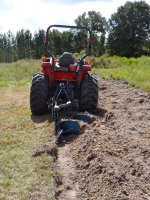1930
Platinum Member
- Joined
- Sep 9, 2018
- Messages
- 920
- Location
- Brandon/Ocala Florida
- Tractor
- Kubota B6100E Kubota L 2501 Kubota T1460
I know very little about farming but that is changing.
Ive staked out an area 200 feet square, at this point there is some bare spots still and some areas where native grasses have taken over.
My plan is to plant sun hemp next season, what is the cheapest/most efficient means to get the seed into the ground?
Once the seed is planted I am under the impression that it will strangle out or block light to anything else living under it which is a benefit for me, I just need to get the seed in the ground without spending a ton of money, I am on a very tight budget because I am trying to meet a financial goal. Thank-you
I have done alot of work to my property, here is a video of some of that work �73property - YouTube
Since making this video I have planted many edible trees and will continue to do so. Thanks
Ive staked out an area 200 feet square, at this point there is some bare spots still and some areas where native grasses have taken over.
My plan is to plant sun hemp next season, what is the cheapest/most efficient means to get the seed into the ground?
Once the seed is planted I am under the impression that it will strangle out or block light to anything else living under it which is a benefit for me, I just need to get the seed in the ground without spending a ton of money, I am on a very tight budget because I am trying to meet a financial goal. Thank-you
I have done alot of work to my property, here is a video of some of that work �73property - YouTube
Since making this video I have planted many edible trees and will continue to do so. Thanks
